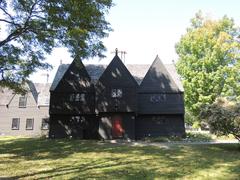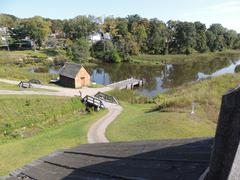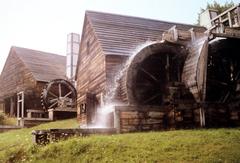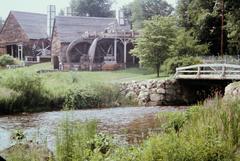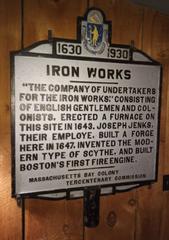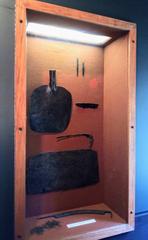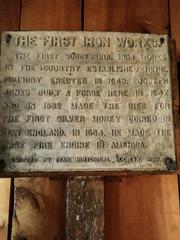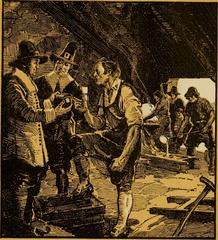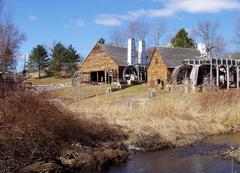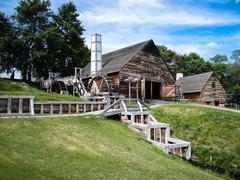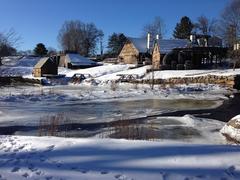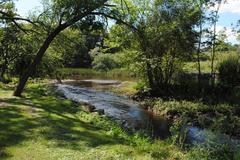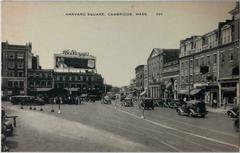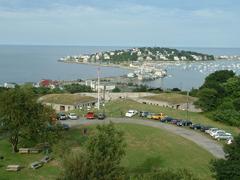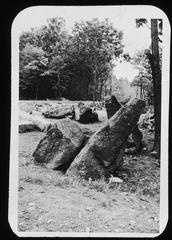
Saugus Iron Works National Historic Site: Visiting Hours, Tickets, and Historical Insights
Date: 31/07/2024
Introduction
The Saugus Iron Works National Historic Site, located in Saugus, Massachusetts, is a must-visit destination for anyone interested in America’s early industrial history. Established in 1646, this site was the first integrated ironworks in North America and played a pivotal role in the industrial development of the American colonies. Founded by the Company of Undertakers for the Iron Works in New England, a group of English investors who recognized the potential of the region’s abundant natural resources (Itemlive), the site’s advanced technology, including a blast furnace and waterwheels powered by the Saugus River, exemplified the ingenuity of early settlers (NPS History). Today, visitors can explore reconstructed buildings, working waterwheels, and a museum that offers a glimpse into 17th-century iron-making processes and daily life. This guide provides comprehensive information on the history, visiting hours, ticket prices, travel tips, and what to expect during your visit to this historic site.
Table of Contents
- [Introduction](#introductionintroduction)
- [History of Saugus Iron Works](#history-of-saugus-iron-workshistory-of-saugus-iron-works)
- [Establishment and Early Operations](#establishment-and-early-operationsestablishment-and-early-operations)
- [Technological Innovations](#technological-innovationstechnological-innovations)
- [Economic and Social Impact](#economic-and-social-impacteconomic-and-social-impact)
- [Decline and Rediscovery](#decline-and-rediscoverydecline-and-rediscovery)
- [Restoration and Preservation](#restoration-and-preservationrestoration-and-preservation)
- [Visitor Information](#visitor-informationvisitor-information)
- [Visiting Hours and Tickets](#visiting-hours-and-ticketsvisiting-hours-and-tickets)
- [Travel Tips and Nearby Attractions](#travel-tips-and-nearby-attractionstravel-tips-and-nearby-attractions)
- [Visitor Experience](#visitor-experiencevisitor-experience)
- [Preservation Efforts](#preservation-effortspreservation-efforts)
- [Frequently Asked Questions (FAQ)](#frequently-asked-questions-faqfrequently-asked-questions-faq)
- [Conclusion](#conclusionconclusion)
History of Saugus Iron Works
Establishment and Early Operations
The Saugus Iron Works, located in Saugus, Massachusetts, holds the distinction of being the first integrated ironworks in North America. Established in 1646, it operated until 1670 and played a crucial role in the early industrial development of the American colonies. The ironworks were founded by a group of English investors known as the Company of Undertakers for the Iron Works in New England. They aimed to capitalize on the abundant natural resources in the Massachusetts Bay Colony, particularly the bog iron ore found in the region. Thomas Dexter, a prominent figure in the early history of Saugus, owned the land on which the ironworks were built. Dexter’s property spanned 350 acres, much of which was farmland (Itemlive). The ironworks complex included a blast furnace, a forge, a rolling and slitting mill, and a blacksmith shop. These facilities were powered by waterwheels driven by the Saugus River, showcasing the ingenuity and resourcefulness of the early settlers.
Technological Innovations
The Saugus Iron Works was notable for its advanced technology and integrated production process. The iron-making process began with the collection of raw materials, including iron ore, charcoal, and limestone. These materials were then smelted in the blast furnace to produce pig iron. The pig iron was further refined in the forge to create wrought iron, which was then processed in the rolling and slitting mill to produce various iron products. The blast furnace at Saugus was a significant technological achievement for its time. It operated at high temperatures, allowing for the efficient extraction of iron from the ore. The furnace was charged with alternating layers of iron ore, charcoal, and limestone, which acted as a flux to remove impurities. The molten iron was then tapped from the furnace and cast into molds to create pig iron ingots (NPS History).
Economic and Social Impact
The establishment of the Saugus Iron Works had a profound impact on the local economy and the broader Massachusetts Bay Colony. The ironworks provided employment for skilled laborers, including ironworkers, carpenters, and blacksmiths. It also stimulated the development of related industries, such as charcoal production and transportation. The iron products manufactured at Saugus were essential for the colony’s infrastructure and daily life. They included tools, nails, and other hardware that were crucial for building homes, ships, and other structures. The ironworks also produced goods for export, contributing to the colony’s trade and economic growth.
Decline and Rediscovery
Despite its initial success, the Saugus Iron Works faced numerous challenges that ultimately led to its decline. The high cost of production, competition from imported iron, and financial difficulties plagued the operation. By 1670, the ironworks had ceased production, and the site fell into disrepair. The significance of the Saugus Iron Works was not fully recognized until the mid-20th century when archaeological excavations and historical research brought its history to light. In 1948, archaeologist Roland W. Robbins led an excavation of the site, uncovering the remains of the blast furnace, forge, and other structures. These findings provided valuable insights into the technology and operations of the ironworks (NPS History).
Restoration and Preservation
The restoration of the Saugus Iron Works began in the early 1950s, spearheaded by the First Iron Works Association with funding from the Iron and Steel Institute. The restoration project aimed to recreate the ironworks as it appeared in the 17th century, using historical documents, archaeological evidence, and traditional craftsmanship. By 1954, the restored site was opened to the public as a private museum (Itemlive). In 1968, the Saugus Iron Works was designated a National Historic Site and transferred to the National Park Service. This designation ensured the long-term preservation and interpretation of the site for future generations. Today, the Saugus Iron Works National Historic Site encompasses 12 acres and includes reconstructed buildings, working waterwheels, and a museum that houses artifacts and exhibits related to the ironworks and its history (Mass History Commons).
Visitor Information
Visiting Hours and Tickets
The Saugus Iron Works National Historic Site is open to the public year-round, with varying hours depending on the season. Generally, the site operates from 9:00 AM to 5:00 PM. It’s recommended to check the official National Park Service website for the most up-to-date visiting hours and any special events or closures. Admission to the Saugus Iron Works National Historic Site is free, making it an accessible and affordable destination for all visitors. However, donations are appreciated to support ongoing preservation efforts.
Travel Tips and Nearby Attractions
When planning your visit to the Saugus Iron Works, consider the following travel tips:
- Transportation: The site is easily accessible by car, with ample parking available. Public transportation options are also available, with bus routes connecting to nearby towns and cities.
- Accessibility: The Saugus Iron Works National Historic Site is committed to providing access for all visitors. Most areas of the site are wheelchair accessible, and assistance is available upon request.
- What to Bring: Comfortable walking shoes, water, and weather-appropriate clothing are recommended for exploring the site. Don’t forget your camera to capture the historic surroundings.
Nearby attractions include the Breakheart Reservation, a beautiful natural area offering hiking trails and scenic views, and the Lynn Woods Reservation, another excellent spot for outdoor activities.
Visitor Experience
Visitors to the Saugus Iron Works National Historic Site can explore the reconstructed ironworks complex, which includes the blast furnace, forge, rolling and slitting mill, and blacksmith shop. The site also features a historic 17th-century home, the Iron Works House, which provides a glimpse into the daily life of the early settlers. The park offers a variety of educational programs and guided tours that highlight the history and significance of the ironworks. Visitors can learn about the iron-making process, the technological innovations of the time, and the impact of the ironworks on the local community and the broader colony. The site also includes a half-mile nature trail that winds through woodlands and marshes, offering opportunities for outdoor recreation and wildlife observation (NPS).
Preservation Efforts
The National Park Service continues to monitor and preserve the Saugus Iron Works National Historic Site. Ongoing efforts include water quality monitoring of the Saugus River, maintenance of the historic structures, and archaeological research to uncover additional information about the site. These efforts ensure that the Saugus Iron Works remains a valuable educational and cultural resource for future generations (NPS History).
Frequently Asked Questions (FAQ)
What are the visiting hours for Saugus Iron Works?
The site is generally open from 9:00 AM to 5:00 PM, but it’s best to check the official website for the most current hours.
How can I buy tickets for Saugus Iron Works?
Admission is free, so no tickets are required. Donations are appreciated to support preservation efforts.
Are there guided tours available?
Yes, the site offers guided tours and educational programs to enhance your visit.
Conclusion
In conclusion, the Saugus Iron Works National Historic Site offers a unique and immersive experience for visitors interested in early American history and industrial heritage. The site’s rich history, technological innovations, and ongoing preservation efforts make it a must-visit destination for history enthusiasts and curious travelers alike. Be sure to check the official website for the latest information on visiting hours and events, and consider exploring nearby attractions to make the most of your trip (NPS).
References
- Itemlive. (2024). Saugus historic iron works was the first in the country. itemlive.com
- NPS History. (n.d.). Saugus Iron Works National Historic Site publications. npshistory.com
- Mass History Commons. (n.d.). Saugus Iron Works project. masshistorycommons.org
- NPS. (n.d.). Things to do at Saugus Iron Works National Historic Site. nps.gov


